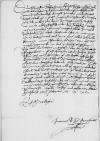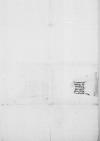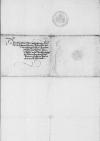Durchlauchterr, hochgebornerr furst, / hochgunstigerr, vilgeliebterr herr und freundt. / Mein freuntlich unnd gancz vleiswillige dienste zuvorann. /
Gestriges tags hab ich Ewer Furstlichen Durchlaucht cf. Albrecht I von Hohenzollern-Ansbach to Ioannes DANTISCUS Königsberg, 1540-02-20, CIDTC IDL 4981⌊cf. Albrecht I von Hohenzollern-Ansbach to Ioannes DANTISCUS Königsberg, 1540-02-20, CIDTC IDL 4981⌋ entfangenn, do nebenn die brive in vorgenomenen sachenn an meinn altenn hoffbruderr, denn Nikolaus Nibschitz (Mikołaj Nipszyc) (*ca. 1483 – †1541), royal courtier, diplomat in the service of Sigismund I and Albrecht von Hohenzollern-Ansbach, Dantiscus' friend; from 1525 until his death an official representative of Duke Albrecht at the Cracow royal court; from 1532 royal secretary; 1519 royal envoy to Albrecht von Hohenzollern, Grand Master of the Teutonic Order, 1525, 1526 envoy to Hungary, 1527 envoy to the Congress in Wrocław, 1531-1533, 1537 envoy to Ferdinand I of Habsburg, 1535-1537, 1540 envoy to Brandenburg, 1536 envoy to the estates of Livonia⌊NibschiczNikolaus Nibschitz (Mikołaj Nipszyc) (*ca. 1483 – †1541), royal courtier, diplomat in the service of Sigismund I and Albrecht von Hohenzollern-Ansbach, Dantiscus' friend; from 1525 until his death an official representative of Duke Albrecht at the Cracow royal court; from 1532 royal secretary; 1519 royal envoy to Albrecht von Hohenzollern, Grand Master of the Teutonic Order, 1525, 1526 envoy to Hungary, 1527 envoy to the Congress in Wrocław, 1531-1533, 1537 envoy to Ferdinand I of Habsburg, 1535-1537, 1540 envoy to Brandenburg, 1536 envoy to the estates of Livonia⌋, / welche ich mit andrenn meinenn morgenn frwe im wil zuschickenn, / zu Gote hoffende, das sie mit meynemm botenn wol und gewislich sollenn zwstelle komenn. / Mein schreibenn sol ouch, / wie ich imm negstenn gemelt, / an die II hern etc. ausghenn etc.
Vor das freuntlich entpittenn / der durchlauchten, hochgebornen Ewer Furstlichen Durchlaucht Dorothea von Oldenburg (*1504 – †1547), Duchess in Prussia (1526-1547); first wife of Albrecht I von Hohenzollern-Ansbach, Duke in Prussia, daughter of Frederic I von Gottorp, King of Denmark, and Anna von Hohenzollern⌊furstinDorothea von Oldenburg (*1504 – †1547), Duchess in Prussia (1526-1547); first wife of Albrecht I von Hohenzollern-Ansbach, Duke in Prussia, daughter of Frederic I von Gottorp, King of Denmark, and Anna von Hohenzollern⌋ und herczog Hansenn thue ich mich gen ire furstliche durchlaucht beyde uffs hochst bedanckenn / und bleib im vorigenn wunschenn, Goth den hochstenn bittende, Ewer und ire furstliche durchlauchten in seiner gnadenn / vor allemm argen, / und das seele unnd leib widrig ist, zu behuttenn und bewarenn, / und thue mich hiemit in Ewer Furstlichen Durchlaucht grosse und erkante gunst mith hochem vleis vortraulich befelenn, / der ich mich mit al meynemm vormugenn genczlich in aller freuntlicherr zuvorsicht / ergebe willig und gehorsamm.



